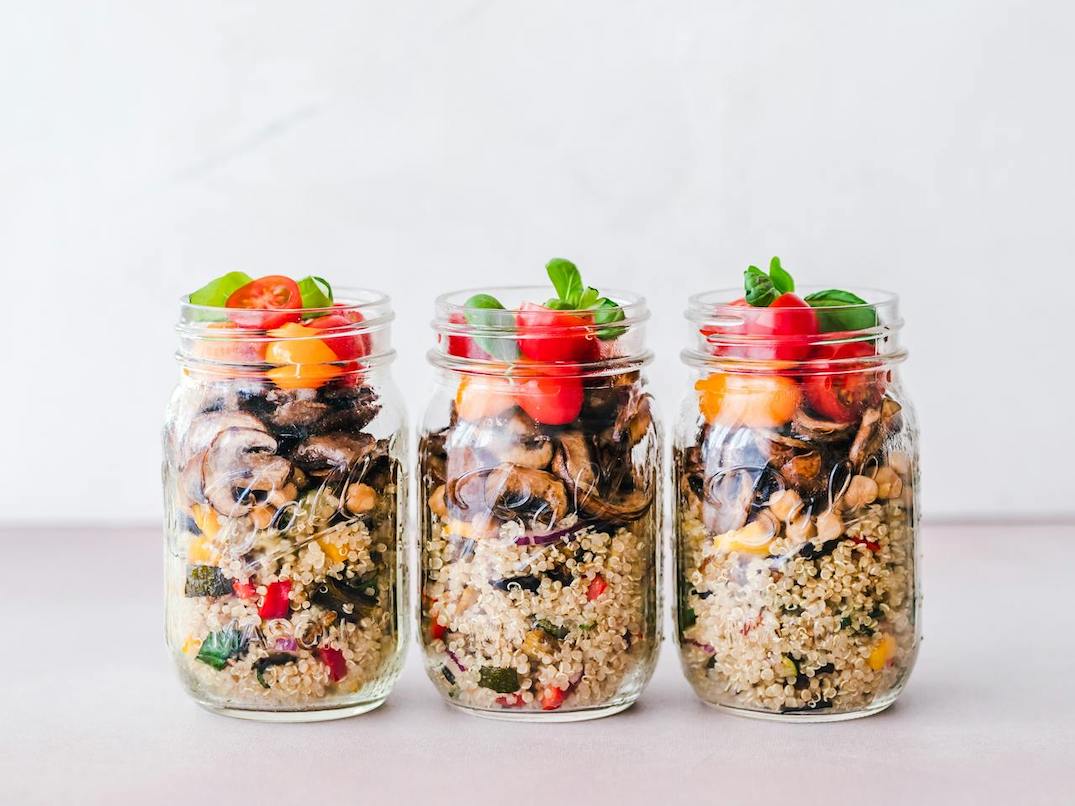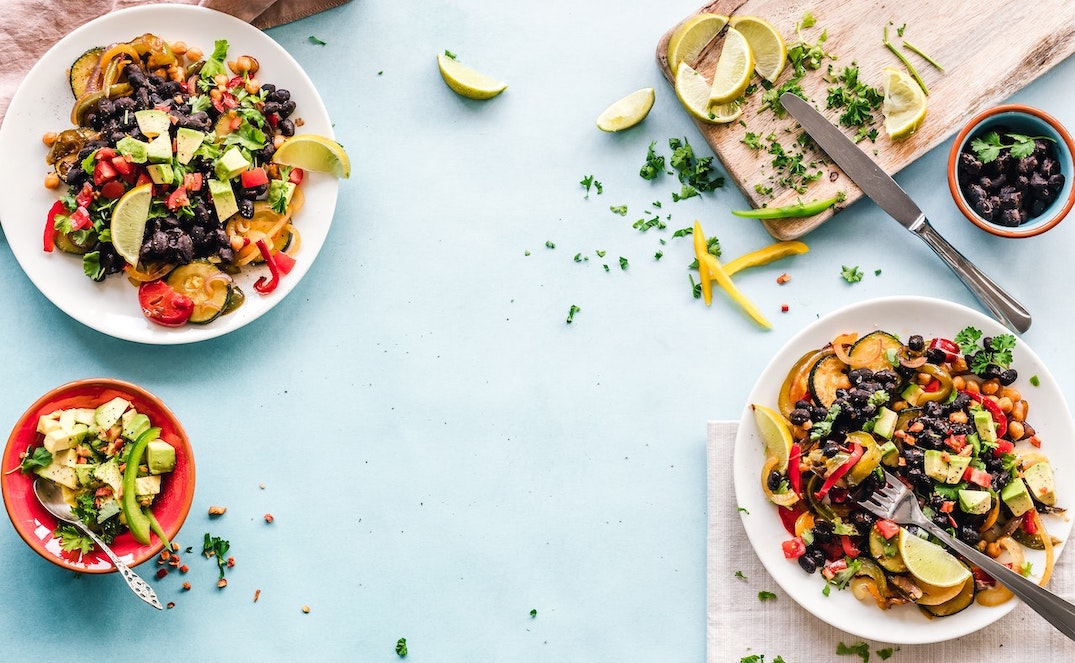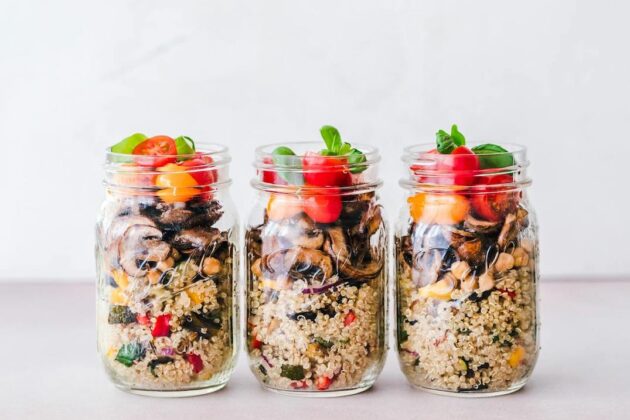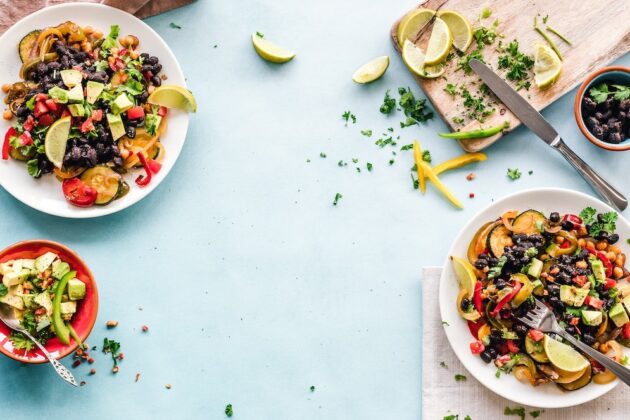7-Day Prediabetes Meal Plan (Free PDF Included)
Being diagnosed with prediabetes can be scary, but making changes to your diet and lifestyle can prevent the onset of type 2 diabetes and other health conditions. A healthy diet can also reverse prediabetes.
An optimal prediabetes meal plan incorporates whole foods such as:
- Fruits
- Vegetables
- Beans and legumes
- Nuts and seeds
- Whole grains
- Low-fat dairy products
- Eggs
- Lean meats and seafood
If you have been diagnosed with prediabetes, you’ll also want to limit or avoid certain foods including:
- Highly processed snack foods
- Sugar-sweetened beverages
- Baked goods and other sweet treats
- Candy
- Refined carbohydrates
- Sweetened cereals
This guide covers the best and worst foods to eat with prediabetes, a sample meal plan, and other tips for reversing prediabetes. We also have a PDF version of our 7-day prediabetes meal plan that you can view and download.
Best foods to eat with prediabetes
Poor diet, sedentary lifestyle, and overweight/obesity are significant risk factors for prediabetes and diabetes. Making healthy diet choices can aid in losing weight and improving blood sugar management to reduce your health risk.
But making changes in your diet is not always easy, especially with misinformation running rampant on social media. If you are looking to improve your prediabetes outlook but aren’t sure what you should be eating, you’re in the right place.
To get you started, consider the diabetes plate method for balancing your meals. Use a typical dinner-size plate and portion out a fourth of that plate with your lean protein source, a fourth a high-fiber carb, and fill the other half with non-starchy vegetables.
Now, start building your plate with these foods that are the best choices for prediabetes:
- Whole grains. Whole grains such as brown rice, quinoa, oats, and whole grain bread are a rich source of dietary fiber and essential nutrients that can improve blood sugar control.
- Leafy greens. Leafy greens such as spinach, kale, and arugula are low in calories and rich in fiber and essential vitamins and minerals. Consuming more of these foods may help reduce the risk of developing type 2 diabetes by improving glycemic control.
- Lean proteins. While meat doesn’t contain carbohydrates, it can contribute a lot of fat to your diet. Lean meats such as poultry, seafood, and plant-based proteins are lower in saturated fats and sodium which can aid in weight loss and reduce heart disease risk.
- Non-starchy vegetables. All vegetables are safe for a prediabetes diet but non-starchy veggies, such as broccoli, Brussels sprouts, cauliflower, and leafy greens, are best. These veggies contain little to no carbohydrates and therefore, do not raise blood sugar levels.
- Low-glycemic fruits. It’s okay to enjoy any kind of fruit even with a prediabetes diagnosis. However, be mindful of your portions and choose more low-glycemic index fruits such as oranges, apples, and berries to further improve glycemic control.
- Healthy fats. Swapping out saturated fats from processed foods for unsaturated fats from fatty fish and plants such as avocado, olives, nuts, and seeds, can reduce type 2 diabetes risk.
- Dairy. Dairy, such as milk, cheese, and yogurt, can be a great source of protein and some research studies have found that fermented dairy products may reduce the risk of developing type 2 diabetes.

Find a dietitian covered by insurance
90% of Zaya Care patients pay $0 for dietitian visits
Foods to avoid with prediabetes
Now that you have an idea of what foods can help improve your prediabetes, let’s talk about foods to limit or avoid. These foods don’t need to be completely restricted but, when consumed frequently, they can contribute to weight gain and insulin resistance.
- Sugary drinks. Regular consumption of sugar-sweetened beverages such as soda, sports drinks, and energy drinks can significantly increase the risk of developing diabetes. According to some studies, it could be as much as a 26% increase with just one to two of these sugary drinks per day.
- Refined grains. Refined grains, such as white bread and white rice, typically contain little to no fiber and can cause a rapid increase in blood sugar. While refined grains are not a significant risk factor for developing diabetes, swapping these out for whole grains has been found to reduce this risk significantly.
- Fried foods. Fried foods such as fried chicken and French fries contain high amounts of fat and calories. Frequent intake of these can cause weight gain and increase the risk of type 2 diabetes and heart disease.
- Highly processed snack foods. Highly processed snack foods, such as chips, cookies, and crackers, contain high amounts of added sugars, fat, and sodium. Frequent consumption of these foods can cause weight gain, hypertension, and increase type 2 diabetes risk by 12% in moderate eaters and up to 31% in frequent eaters.
- Baked goods and other sugary treats. Baked goods and other sugary treats contain high amounts of added sugars and calories. These can cause weight gain and insulin resistance, both precursors to prediabetes and diabetes.
7-day prediabetes meal plan
Here is a sample 7-day prediabetes meal plan that includes many of the best foods listed above while avoiding those that can make the condition worse.
This meal plan equals roughly 1,800 calories per day. Your ideal diet may have more or fewer calories and incorporate different foods based on your intolerances, preferences, and other medical conditions.
Remember, it’s always important to talk to your doctor and/or dietitian before making any drastic changes to your diet to learn what is best for your situation.
We also recommend working with a registered dietitian to create a prediabetes meal plan that is tailored to your situation.
If you want to view/download the PDF version of the meal plan, click here.
Day 1
Breakfast
- Scrambled eggs with spinach and mushrooms
- Herbal tea
Morning Snack
- Carrot sticks with mashed avocado
Lunch
- Grilled chicken breast with a salad of mixed greens and cherry tomatoes
- Quinoa
Afternoon Snack
- Cucumber slices with hummus
Dinner
- Baked salmon with steamed broccoli and a side of brown rice
Evening Snack
- A small apple with natural peanut butter
Day 2
Breakfast
- Greek yogurt with blueberries and a sprinkle of flaxseeds
- Black coffee
Morning Snack
- A banana with natural almond butter
Lunch
- Turkey wrap (using a whole grain tortilla) filled with lettuce, cucumber, and a bit of mustard
- Side of bell peppers
Afternoon Snack
- Raw snap peas
Dinner
- Chicken stir-fry with a variety of vegetables (like bell peppers and broccoli) over quinoa
Evening Snack
- A handful of almonds
Day 3
Breakfast
- Oatmeal with sliced strawberries and a sprinkle of cinnamon
- 1 hard-boiled egg
- Green tea
Morning Snack
- Orange slices with a small portion of pistachios
Lunch
- Grilled turkey burger (no bun) with a side salad of arugula and cherry tomatoes
- Half a baked sweet potato
Afternoon Snack
- Sliced bell peppers with hummus
Dinner
- Baked fish (like tilapia) with asparagus and leftover brown rice
Evening Snack
- Cottage cheese with sliced cucumber

Find a dietitian covered by insurance
90% of Zaya Care patients pay $0 for dietitian visits
Day 4
Breakfast
- Smoothie with spinach, half a banana, protein powder, and almond milk
- Herbal tea
Morning Snack
- Grapefruit slices with a small portion of cheese
Lunch
- Chicken salad with mixed greens, avocado, and olive oil dressing
- Quinoa
Afternoon Snack
- Carrot sticks
Dinner
- Turkey meatballs with a medley of sautéed non-starchy vegetables (zucchini, bell peppers)
- A small serving of whole grain pasta
Evening Snack
- A small peach with Greek yogurt
Day 5
Breakfast
- Egg white omelet with mushrooms and spinach
- Black coffee
Morning Snack
- Kiwi fruit
Lunch
- Baked chicken with roasted Brussels sprouts and a side of farro
Afternoon Snack
- Sliced apple with a few walnuts
Dinner
- Grilled fish (like salmon) with a large mixed greens salad
- Half a baked sweet potato
Evening Snack
- Greek yogurt
Day 6
Breakfast
- Greek yogurt with sliced bananas and a handful of walnuts
- Green tea
Morning Snack
- Raw snap peas with light cream cheese
Lunch
- Quinoa salad with grilled chicken, cherry tomatoes, cucumbers, and avocado
- Olive oil and lemon juice dressing
Afternoon Snack
- Carrot and cucumber sticks with hummus
Dinner
- Turkey stir-fry with a variety of vegetables (like broccoli and carrots) over brown rice
Evening Snack
- A few almonds
Day 7
Breakfast
- Oatmeal with blueberries and flax seeds
- Herbal tea
Morning Snack
- An orange with a small handful of almonds
Lunch
- Grilled salmon with a large salad of arugula, bell peppers, and cucumbers
- Quinoa
Afternoon Snack
- Greek yogurt with sliced strawberries
Dinner
- Chicken breast with a side of steamed green beans and farro
Evening Snack
- Cottage cheese with pineapple slices
Tips for creating your prediabetes meal plan
When creating your prediabetes meal plan, consider your food preferences and what feels feasible for you in terms of meal preparation, cost, and food availability.
Below are some additional tips to help you create a prediabetes meal plan that works for you:
- Follow the ADA’s recommended portions. Use the diabetes plate method to help you portion out your meals: ¼ of your plate lean protein (chicken, turkey, seafood), ¼ of your plate carbohydrates (fruit, whole grain bread, pasta), and ½ of your plate non-starchy veggies (leafy greens, broccoli, carrots).
- Find your sugar limit. It’s recommended to limit added sugars to less than 6% of your total calorie intake per day or about 100 calories per day for women and 150 for men. Each gram of added sugar in a product contains 4 calories.
- Keep the 5-20 rule in mind. An easy way to limit your total sugar intake is to follow this rule which suggests choosing products that contain less than 5% of the %DV for sugar and avoiding those that contain 20% or more. The %DV is the recommended amount of each nutrient to consume or not exceed each day.
- Meal prep before each week. Planning and prepping your meals ahead of time for the week can make it easier to stick with your meal plan. You will be less likely to make poor choices out of convenience.
- Swap refined grains for whole grains. While all types of carbs can fit in a healthy diet, choosing more whole grain options can help balance blood sugar levels. Make easy swaps for items you eat regularly, such as choosing a whole grain bread instead of white or swapping out white rice for quinoa.
- Load up on fiber. Fiber can help increase satiety during meals, balance blood sugar levels, and help you maintain a healthy weight. Include more fiber-rich options in your meal such as fruits, vegetables, beans, legumes, and whole grains.
- Avoid drinking calories. Calorie-rich beverages often contain large portions of added sugars and can cause weight gain. Choose no-calorie or low-calorie beverages when possible or stick with plain water.
- Slow down while eating. Take your time during meals and enjoy your food at a slower pace so you can learn to recognize your body’s natural satiety cues.
- Track what you eat. Tracking what you eat can help you better understand your food patterns and make you more aware of the choices you are making. This can help you address problem areas and adjust your meal plan to help you meet your goals.
- Stay hydrated. Maintaining adequate hydration can help you manage your hunger levels and your blood sugars throughout the day.
- Avoid distractions during mealtime. Distracted eating, such as eating in front of the tv or computer, can cause you to eat larger portions and feel less satisfied. This can lead to weight gain and worsen blood glucose control. Eat meals at the table when you can and focus only on enjoying that meal.
- Don’t over-restrict. While we want to limit intake of sugary foods, it’s important that you don’t over-restrict yourself or it will not be sustainable long term. If you have a strong sweet craving, enjoy a small portion of that food. It can help to improve blood sugar management to pair a sweet treat with a protein or healthy fat.
Why we recommend working with a Registered Dietitian if you have prediabetes
A prediabetes diagnosis can put you at a significantly higher risk of developing type 2 diabetes and heart disease. This is an important time to take control of your health by making the necessary changes in your diet and lifestyle.
But change can be tough so don’t do it alone. Working with a registered dietitian (RD) specializing in diabetes can help.
RDs are nutrition professionals who specialize in helping people make changes in their diet to better control their conditions, including prediabetes. RDs can provide you with individualized guidance and support to help you meet your goals and be the healthiest version of you.
Don’t let the internet, friends, or family try to guide you with their advice. Get the right information, helpful tips, and ongoing support from a professional and take the guesswork out of managing your prediabetes.
You can use Zaya Care’s free Dietitian Search Tool to take the first step toward prediabetes management with an RD on your side.
When you request an appointment with one of our Registered Dietitians here at Zaya Care, we’ll check your insurance so you know exactly how much you’ll have to pay, if anything at all.
It’s worth noting that 90% of Zaya Care patients pay $0 for nutrition care with a registered dietitian as we are in-network with many major carriers.

Find a dietitian covered by insurance
90% of Zaya Care patients pay $0 for dietitian visits
Other tips for managing prediabetes
Diet is one of the most important factors to consider when working to improve your prediabetes diagnosis, but it’s not the only factor. Below are some additional tips to help you manage your condition and get back on track with your health.
- Try to lose some weight. If you are overweight, losing weight can significantly improve your prediabetes and decrease the risk of developing other health conditions. Even a weight loss of 5% can make an impact.
- Find exercise you enjoy & do it regularly. Regular exercise can aid in weight loss and help you better manage your blood sugar levels but it’s not one-size-fits-all. Try different types of exercise and find what you enjoy. If you like doing it, you’ll find it easier to include in your daily routine.
- Avoid alcohol and tobacco. Regular alcohol consumption and tobacco use are risk factors for developing prediabetes and diabetes. If you already have these conditions, it can make them more difficult to manage.
- Keep track of your numbers. Schedule regular visits with your doctor to assess your numbers. Knowing important lab values, such as your fasting blood sugar levels, hemoglobin A1C, and cholesterol levels can help you see your progress and adjust your plan as needed.
- Manage stress as best you can. Stress can raise blood sugar levels and worsen prediabetes. Keep your stress in check by practicing stress management techniques such as deep breathing exercises, meditation, yoga, and regular physical activity.
- Get plenty of sleep. Sleep deprivation can cause extra stress on your body which can spell trouble for your blood sugar. It can also cause alterations in your appetite that could potentially lead to weight gain. Aim to get seven to nine hours of sleep each night.
Being diagnosed with prediabetes can be scary, but making changes to your diet and lifestyle can prevent the onset of type 2 diabetes and other health conditions. A healthy diet can also reverse prediabetes.
An optimal prediabetes meal plan incorporates whole foods such as:
- Fruits
- Vegetables
- Beans and legumes
- Nuts and seeds
- Whole grains
- Low-fat dairy products
- Eggs
- Lean meats and seafood
If you have been diagnosed with prediabetes, you’ll also want to limit or avoid certain foods including:
- Highly processed snack foods
- Sugar-sweetened beverages
- Baked goods and other sweet treats
- Candy
- Refined carbohydrates
- Sweetened cereals
This guide covers the best and worst foods to eat with prediabetes, a sample meal plan, and other tips for reversing prediabetes. We also have a PDF version of our 7-day prediabetes meal plan that you can view and download.
Best foods to eat with prediabetes
Poor diet, sedentary lifestyle, and overweight/obesity are significant risk factors for prediabetes and diabetes. Making healthy diet choices can aid in losing weight and improving blood sugar management to reduce your health risk.
But making changes in your diet is not always easy, especially with misinformation running rampant on social media. If you are looking to improve your prediabetes outlook but aren’t sure what you should be eating, you’re in the right place.
To get you started, consider the diabetes plate method for balancing your meals. Use a typical dinner-size plate and portion out a fourth of that plate with your lean protein source, a fourth a high-fiber carb, and fill the other half with non-starchy vegetables.
Now, start building your plate with these foods that are the best choices for prediabetes:
- Whole grains. Whole grains such as brown rice, quinoa, oats, and whole grain bread are a rich source of dietary fiber and essential nutrients that can improve blood sugar control.
- Leafy greens. Leafy greens such as spinach, kale, and arugula are low in calories and rich in fiber and essential vitamins and minerals. Consuming more of these foods may help reduce the risk of developing type 2 diabetes by improving glycemic control.
- Lean proteins. While meat doesn’t contain carbohydrates, it can contribute a lot of fat to your diet. Lean meats such as poultry, seafood, and plant-based proteins are lower in saturated fats and sodium which can aid in weight loss and reduce heart disease risk.
- Non-starchy vegetables. All vegetables are safe for a prediabetes diet but non-starchy veggies, such as broccoli, Brussels sprouts, cauliflower, and leafy greens, are best. These veggies contain little to no carbohydrates and therefore, do not raise blood sugar levels.
- Low-glycemic fruits. It’s okay to enjoy any kind of fruit even with a prediabetes diagnosis. However, be mindful of your portions and choose more low-glycemic index fruits such as oranges, apples, and berries to further improve glycemic control.
- Healthy fats. Swapping out saturated fats from processed foods for unsaturated fats from fatty fish and plants such as avocado, olives, nuts, and seeds, can reduce type 2 diabetes risk.
- Dairy. Dairy, such as milk, cheese, and yogurt, can be a great source of protein and some research studies have found that fermented dairy products may reduce the risk of developing type 2 diabetes.

Find a dietitian covered by insurance
90% of Zaya Care patients pay $0 for dietitian visits
Foods to avoid with prediabetes
Now that you have an idea of what foods can help improve your prediabetes, let’s talk about foods to limit or avoid. These foods don’t need to be completely restricted but, when consumed frequently, they can contribute to weight gain and insulin resistance.
- Sugary drinks. Regular consumption of sugar-sweetened beverages such as soda, sports drinks, and energy drinks can significantly increase the risk of developing diabetes. According to some studies, it could be as much as a 26% increase with just one to two of these sugary drinks per day.
- Refined grains. Refined grains, such as white bread and white rice, typically contain little to no fiber and can cause a rapid increase in blood sugar. While refined grains are not a significant risk factor for developing diabetes, swapping these out for whole grains has been found to reduce this risk significantly.
- Fried foods. Fried foods such as fried chicken and French fries contain high amounts of fat and calories. Frequent intake of these can cause weight gain and increase the risk of type 2 diabetes and heart disease.
- Highly processed snack foods. Highly processed snack foods, such as chips, cookies, and crackers, contain high amounts of added sugars, fat, and sodium. Frequent consumption of these foods can cause weight gain, hypertension, and increase type 2 diabetes risk by 12% in moderate eaters and up to 31% in frequent eaters.
- Baked goods and other sugary treats. Baked goods and other sugary treats contain high amounts of added sugars and calories. These can cause weight gain and insulin resistance, both precursors to prediabetes and diabetes.
7-day prediabetes meal plan
Here is a sample 7-day prediabetes meal plan that includes many of the best foods listed above while avoiding those that can make the condition worse.
This meal plan equals roughly 1,800 calories per day. Your ideal diet may have more or fewer calories and incorporate different foods based on your intolerances, preferences, and other medical conditions.
Remember, it’s always important to talk to your doctor and/or dietitian before making any drastic changes to your diet to learn what is best for your situation.
We also recommend working with a registered dietitian to create a prediabetes meal plan that is tailored to your situation.
If you want to view/download the PDF version of the meal plan, click here.
Day 1
Breakfast
- Scrambled eggs with spinach and mushrooms
- Herbal tea
Morning Snack
- Carrot sticks with mashed avocado
Lunch
- Grilled chicken breast with a salad of mixed greens and cherry tomatoes
- Quinoa
Afternoon Snack
- Cucumber slices with hummus
Dinner
- Baked salmon with steamed broccoli and a side of brown rice
Evening Snack
- A small apple with natural peanut butter
Day 2
Breakfast
- Greek yogurt with blueberries and a sprinkle of flaxseeds
- Black coffee
Morning Snack
- A banana with natural almond butter
Lunch
- Turkey wrap (using a whole grain tortilla) filled with lettuce, cucumber, and a bit of mustard
- Side of bell peppers
Afternoon Snack
- Raw snap peas
Dinner
- Chicken stir-fry with a variety of vegetables (like bell peppers and broccoli) over quinoa
Evening Snack
- A handful of almonds
Day 3
Breakfast
- Oatmeal with sliced strawberries and a sprinkle of cinnamon
- 1 hard-boiled egg
- Green tea
Morning Snack
- Orange slices with a small portion of pistachios
Lunch
- Grilled turkey burger (no bun) with a side salad of arugula and cherry tomatoes
- Half a baked sweet potato
Afternoon Snack
- Sliced bell peppers with hummus
Dinner
- Baked fish (like tilapia) with asparagus and leftover brown rice
Evening Snack
- Cottage cheese with sliced cucumber

Find a dietitian covered by insurance
90% of Zaya Care patients pay $0 for dietitian visits
Day 4
Breakfast
- Smoothie with spinach, half a banana, protein powder, and almond milk
- Herbal tea
Morning Snack
- Grapefruit slices with a small portion of cheese
Lunch
- Chicken salad with mixed greens, avocado, and olive oil dressing
- Quinoa
Afternoon Snack
- Carrot sticks
Dinner
- Turkey meatballs with a medley of sautéed non-starchy vegetables (zucchini, bell peppers)
- A small serving of whole grain pasta
Evening Snack
- A small peach with Greek yogurt
Day 5
Breakfast
- Egg white omelet with mushrooms and spinach
- Black coffee
Morning Snack
- Kiwi fruit
Lunch
- Baked chicken with roasted Brussels sprouts and a side of farro
Afternoon Snack
- Sliced apple with a few walnuts
Dinner
- Grilled fish (like salmon) with a large mixed greens salad
- Half a baked sweet potato
Evening Snack
- Greek yogurt
Day 6
Breakfast
- Greek yogurt with sliced bananas and a handful of walnuts
- Green tea
Morning Snack
- Raw snap peas with light cream cheese
Lunch
- Quinoa salad with grilled chicken, cherry tomatoes, cucumbers, and avocado
- Olive oil and lemon juice dressing
Afternoon Snack
- Carrot and cucumber sticks with hummus
Dinner
- Turkey stir-fry with a variety of vegetables (like broccoli and carrots) over brown rice
Evening Snack
- A few almonds
Day 7
Breakfast
- Oatmeal with blueberries and flax seeds
- Herbal tea
Morning Snack
- An orange with a small handful of almonds
Lunch
- Grilled salmon with a large salad of arugula, bell peppers, and cucumbers
- Quinoa
Afternoon Snack
- Greek yogurt with sliced strawberries
Dinner
- Chicken breast with a side of steamed green beans and farro
Evening Snack
- Cottage cheese with pineapple slices
Tips for creating your prediabetes meal plan
When creating your prediabetes meal plan, consider your food preferences and what feels feasible for you in terms of meal preparation, cost, and food availability.
Below are some additional tips to help you create a prediabetes meal plan that works for you:
- Follow the ADA’s recommended portions. Use the diabetes plate method to help you portion out your meals: ¼ of your plate lean protein (chicken, turkey, seafood), ¼ of your plate carbohydrates (fruit, whole grain bread, pasta), and ½ of your plate non-starchy veggies (leafy greens, broccoli, carrots).
- Find your sugar limit. It’s recommended to limit added sugars to less than 6% of your total calorie intake per day or about 100 calories per day for women and 150 for men. Each gram of added sugar in a product contains 4 calories.
- Keep the 5-20 rule in mind. An easy way to limit your total sugar intake is to follow this rule which suggests choosing products that contain less than 5% of the %DV for sugar and avoiding those that contain 20% or more. The %DV is the recommended amount of each nutrient to consume or not exceed each day.
- Meal prep before each week. Planning and prepping your meals ahead of time for the week can make it easier to stick with your meal plan. You will be less likely to make poor choices out of convenience.
- Swap refined grains for whole grains. While all types of carbs can fit in a healthy diet, choosing more whole grain options can help balance blood sugar levels. Make easy swaps for items you eat regularly, such as choosing a whole grain bread instead of white or swapping out white rice for quinoa.
- Load up on fiber. Fiber can help increase satiety during meals, balance blood sugar levels, and help you maintain a healthy weight. Include more fiber-rich options in your meal such as fruits, vegetables, beans, legumes, and whole grains.
- Avoid drinking calories. Calorie-rich beverages often contain large portions of added sugars and can cause weight gain. Choose no-calorie or low-calorie beverages when possible or stick with plain water.
- Slow down while eating. Take your time during meals and enjoy your food at a slower pace so you can learn to recognize your body’s natural satiety cues.
- Track what you eat. Tracking what you eat can help you better understand your food patterns and make you more aware of the choices you are making. This can help you address problem areas and adjust your meal plan to help you meet your goals.
- Stay hydrated. Maintaining adequate hydration can help you manage your hunger levels and your blood sugars throughout the day.
- Avoid distractions during mealtime. Distracted eating, such as eating in front of the tv or computer, can cause you to eat larger portions and feel less satisfied. This can lead to weight gain and worsen blood glucose control. Eat meals at the table when you can and focus only on enjoying that meal.
- Don’t over-restrict. While we want to limit intake of sugary foods, it’s important that you don’t over-restrict yourself or it will not be sustainable long term. If you have a strong sweet craving, enjoy a small portion of that food. It can help to improve blood sugar management to pair a sweet treat with a protein or healthy fat.
Why we recommend working with a Registered Dietitian if you have prediabetes
A prediabetes diagnosis can put you at a significantly higher risk of developing type 2 diabetes and heart disease. This is an important time to take control of your health by making the necessary changes in your diet and lifestyle.
But change can be tough so don’t do it alone. Working with a registered dietitian (RD) specializing in diabetes can help.
RDs are nutrition professionals who specialize in helping people make changes in their diet to better control their conditions, including prediabetes. RDs can provide you with individualized guidance and support to help you meet your goals and be the healthiest version of you.
Don’t let the internet, friends, or family try to guide you with their advice. Get the right information, helpful tips, and ongoing support from a professional and take the guesswork out of managing your prediabetes.
You can use Zaya Care’s free Dietitian Search Tool to take the first step toward prediabetes management with an RD on your side.
When you request an appointment with one of our Registered Dietitians here at Zaya Care, we’ll check your insurance so you know exactly how much you’ll have to pay, if anything at all.
It’s worth noting that 90% of Zaya Care patients pay $0 for nutrition care with a registered dietitian as we are in-network with many major carriers.

Find a dietitian covered by insurance
90% of Zaya Care patients pay $0 for dietitian visits
Other tips for managing prediabetes
Diet is one of the most important factors to consider when working to improve your prediabetes diagnosis, but it’s not the only factor. Below are some additional tips to help you manage your condition and get back on track with your health.
- Try to lose some weight. If you are overweight, losing weight can significantly improve your prediabetes and decrease the risk of developing other health conditions. Even a weight loss of 5% can make an impact.
- Find exercise you enjoy & do it regularly. Regular exercise can aid in weight loss and help you better manage your blood sugar levels but it’s not one-size-fits-all. Try different types of exercise and find what you enjoy. If you like doing it, you’ll find it easier to include in your daily routine.
- Avoid alcohol and tobacco. Regular alcohol consumption and tobacco use are risk factors for developing prediabetes and diabetes. If you already have these conditions, it can make them more difficult to manage.
- Keep track of your numbers. Schedule regular visits with your doctor to assess your numbers. Knowing important lab values, such as your fasting blood sugar levels, hemoglobin A1C, and cholesterol levels can help you see your progress and adjust your plan as needed.
- Manage stress as best you can. Stress can raise blood sugar levels and worsen prediabetes. Keep your stress in check by practicing stress management techniques such as deep breathing exercises, meditation, yoga, and regular physical activity.
- Get plenty of sleep. Sleep deprivation can cause extra stress on your body which can spell trouble for your blood sugar. It can also cause alterations in your appetite that could potentially lead to weight gain. Aim to get seven to nine hours of sleep each night.
















